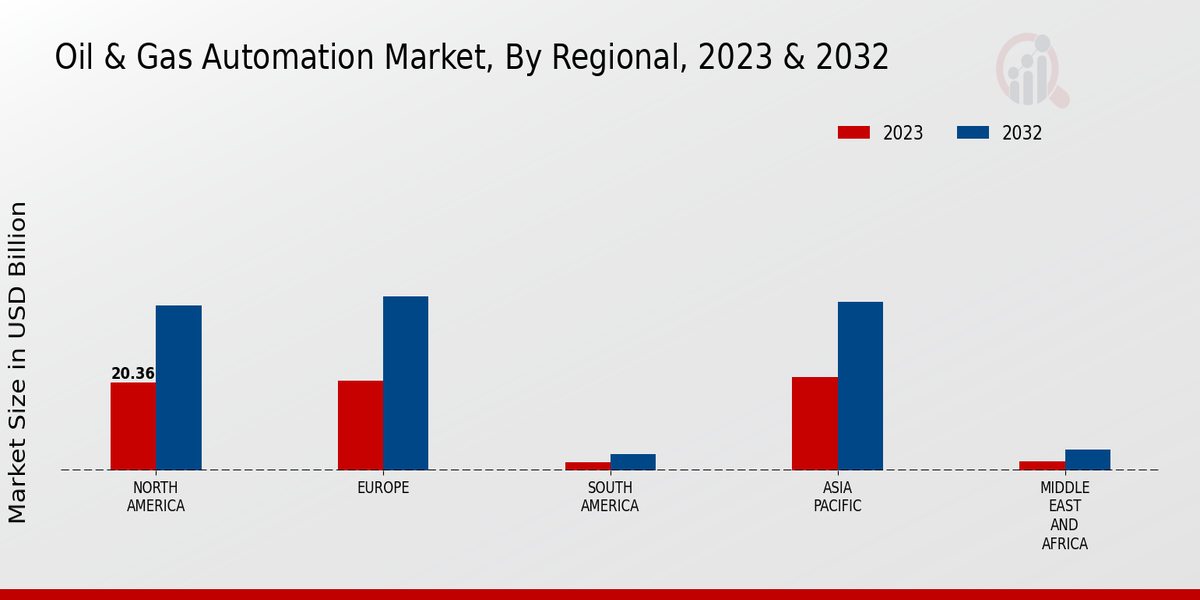Regulatory Compliance
Regulatory compliance remains a critical driver in the Global Oil and Gas Automation Market Industry. Governments worldwide are implementing stringent regulations to ensure safety, environmental protection, and operational efficiency. Automation technologies facilitate compliance by providing real-time monitoring and reporting capabilities. For example, automated systems can track emissions and ensure adherence to environmental standards, thereby reducing the risk of penalties. As regulations become more rigorous, the demand for automation solutions that streamline compliance processes is likely to increase, further propelling market growth.
Global Market Expansion
The Global Oil and Gas Automation Market Industry is witnessing expansion into emerging markets, which serves as a significant driver for growth. Countries in Asia-Pacific, the Middle East, and Africa are increasingly investing in oil and gas exploration and production. Automation technologies are being adopted to enhance operational efficiency and safety in these regions. For instance, countries like India and Saudi Arabia are implementing automation solutions to modernize their oil and gas sectors. This expansion into new markets is likely to bolster the overall growth of the industry, as companies seek to capitalize on untapped resources and improve their competitive positions.
Market Growth Projections
The Global Oil and Gas Automation Market Industry is projected to experience substantial growth over the coming years. With a market value expected to reach 69.0 USD Billion in 2024 and an anticipated increase to 155.2 USD Billion by 2035, the industry is poised for a robust expansion. The compound annual growth rate of 7.65% from 2025 to 2035 indicates a strong upward trajectory. This growth is driven by various factors, including technological advancements, regulatory compliance, and increased investment in infrastructure. The market's expansion reflects the critical role of automation in enhancing operational efficiency and meeting the evolving demands of the energy sector.
Technological Advancements
The Global Oil and Gas Automation Market Industry is experiencing rapid technological advancements that enhance operational efficiency and safety. Innovations such as artificial intelligence, machine learning, and the Internet of Things are being integrated into automation systems. For instance, predictive maintenance technologies are being deployed to minimize downtime and optimize asset performance. These advancements are projected to contribute to the market's growth, which is expected to reach 69.0 USD Billion in 2024. As companies increasingly adopt these technologies, the overall productivity and profitability of operations are likely to improve, thereby driving further investments in automation.
Rising Demand for Energy Efficiency
The Global Oil and Gas Automation Market Industry is significantly influenced by the rising demand for energy efficiency. As energy prices fluctuate and environmental concerns grow, companies are seeking ways to optimize their operations and reduce costs. Automation technologies enable real-time data analysis and process optimization, which can lead to substantial energy savings. For instance, automated drilling systems can enhance resource extraction while minimizing energy consumption. This focus on efficiency is expected to drive the market, with projections indicating a growth to 155.2 USD Billion by 2035, reflecting a compound annual growth rate of 7.65% from 2025 to 2035.
Increased Investment in Infrastructure
Increased investment in infrastructure is a pivotal driver for the Global Oil and Gas Automation Market Industry. As countries strive to enhance their energy infrastructure, there is a growing emphasis on modernizing existing facilities and developing new ones. Automation plays a crucial role in this modernization effort, as it enhances operational efficiency and safety. For example, investments in automated pipeline monitoring systems can significantly reduce the risk of leaks and failures. This trend is expected to contribute to the market's expansion, as stakeholders recognize the value of automation in supporting infrastructure development.



















Leave a Comment